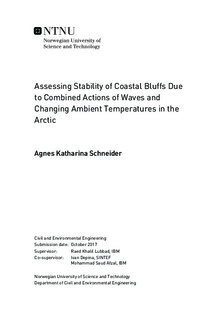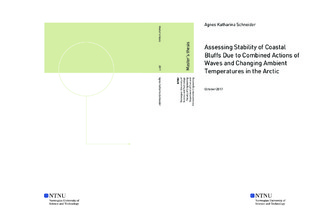| dc.description.abstract | The Arctic coastal zone is characterized by high erosion rates, which are on average 0,5 m/year but can reach up locally to 25 m/year and therefore endanger coastal infrastructure. Additionally, the global warming takes place twice as fast in the Arctic than in the rest of world, resulting in an expected increase of the erosion rates and a further acceleration of the climate change. Furthermore, warmer temperatures and a retreat of sea ice cover favour human activities in the Arctic regions. Therefore, it is very important to develop reliable ways to model and forecast coastal erosion in the Arctic.
This thesis provides a new approach in simulating the thermodenudation erosion process using the geotechnical software Plaxis. The developed Thermodenudation Model is a combination of a thermo-hydraulic model, which considers the cryogenic suction as an important process within frozen soil, coupled with a mechanical model via Python program codes to allow the analysis of slope stability and coastal retreat rates. Additionally, a separate Excel sheet was developed to determine the volume of eroded soil.
This model was then calibrated and partly validated to the situation at Baydara Bay a coastline in west Russia, obtaining good results, which are very close to measured data. To investigate the effects of climate change on Baydara Bay until the end of this century a temperature increase was simulated with the Thermodenudation Model in several scenarios, whereby the calculated results regarding the active layer thickness, the coastal retreat rate and the volume of eroded soil are reasonable and comply with predicted developments. Additionally, investigations regarding the bearing capacity of the bluff and coastal protection measures and a parameter variation were conducted. | |

